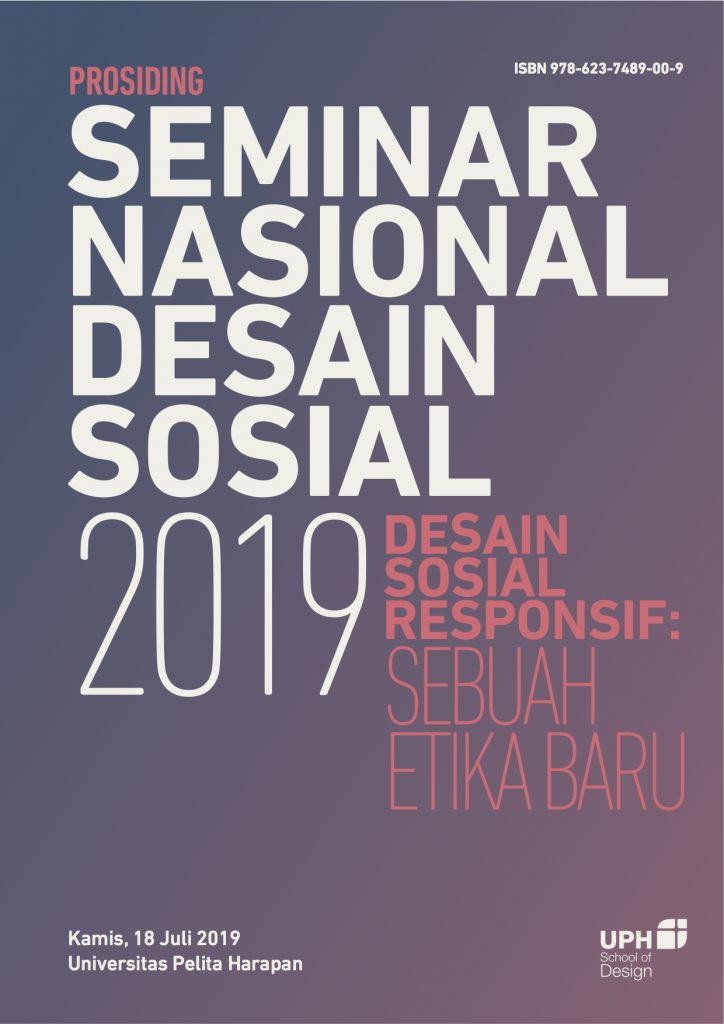'Peniti Project': Mendesain Startup Clothes Sharing
Abstract
Fakultas Desain (School of Design) mengembangkan MK. Design, Society & Environment (DSE) yang dirancang sebagai demonstrasi praktik tridharma terutama dalam melaksanakan penelitian dan pengabdian kepada masyarakat secara kolaboratif dan berdampak langsung kepada masyarakat melalui desain. Kegiatan MK. DSE di Prodi Desain Interior, SoD, UPH kali ini dimulai pada semester ganjil tahun akademik 2017/2018 dan berakhir pada semester genap 2017/2018 adalah awal dari eksperimen menggabungkan kemajuan teknologi. Pada kegiatan ini para dosen dan mahasiswa/i bekerja sama dengan Design as Generator (DAG) dalam konteks lingkungan Universitas Pelita Harapan (UPH), mengembangkan dan mendesain model inisiatif startup clothes sharing. Model inisiatif ini hendak merespon tren fast-fashion yang tidak ramah lingkungan dengan slow-fashion, sehingga seseorang tetap dapat fashionable namun sekaligus tetap sadar dan ramah lingkungan berkelanjutan.
References
Katoppo, M. L., dkk. (2014). Design as Generator (DAG): an architectural approach for empowering community (republished as Design as Generator (DAG): an architectural approach for empowering community). DIMENSI Journal of Architecture and Built Environment 2:41: 85- 94.
Katoppo, M. L. dan Sudradjat, I. (2015). Combining Participatory Action Research (PAR) and Design Thinking (DT) as an alternative research method in architecture. Procedia - Social and Behavioral Sciences 184 C (2015): 118-125.
Katoppo, M. L., Triyadi, S., dan Siregar, M. J. (2016). Redefine architecture as social innovation for empowering community. Sriwijaya International Conference on Engineering, Science and Technology (SICEST) 2016 proceeding with ISBN No. 979-587-621-1.
Katoppo, M. L., Triyadi, S., dan Siregar, M. J. (2017). Memory, hope and ssense - Design as Generator (DAG) premises for empowering community. Advanced Science Letters(indexed by scopus), 23:7:6095-6101.
Katoppo, Martin L. (2017). DESAIN SEBAGAI GENERATOR PEMBERDAYAAN MASYARAKAT. Disertasi Program Doktor, Institut Teknologi Bandung.
Brown, T. (2008). Design thinking. www.unusualleading.com. Harvard Business Review: 1-9.
Brown, T. dan Katz, B. (2009). Change by design: how design thinking transforms organizations and inspires innovations. New York: HarperCollins Publishers.
Brown, T., dan Wyatt, J. (2010). Design thinking for social innovation. Stanford Social Innovation Review, Stanford School of Business: 29-35.
IDEO (2013). Human centered design (HCD) toolkit: design thinking toolkit for social innovation project, 2nd.ed. Licensed under The Creative Commons Attribution, Non Commercial, Share A-Like 3.0 Unported License, with IDE, Heifer international and ICRW, funded by Bill and Melinda Gates Foundation.
Creswell, J. W. (3rd ed. © 2008, 2005, 2002): Educational research - planning, conducting, and evaluating quantitative and qualitative research. New Jersey: Pearson Education. Inc, Pearson International Edition.
Neuman, L. W. (2006). Social research methods - qualitative and quantitative approaches. Boston, NY, SF: Pearson Education, Inc.
Jenkins, P. dan Forsyth, L. (2010). Architecture, Participation and Society. New York: Routledge.
Jones, P. B., Petrescu, D., dan Till, J. (2005). Architecture and Participation. New York: Spon Publishing.




.png)
.png)
